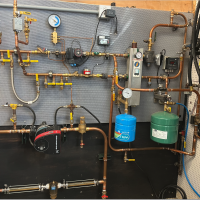Best Of
Re: Steam-one boiler or two, and, Atmospheric vs Gun
Using 2 boilers with Steam, you will most likely have both boilers start at the same time and produce enough steam to get the pressure up to about 3/4 of the operating pressure then have a boiler drop out. The other boiler will keep operating until the call for heat is satisfied. If the one boiler can not keep the pressure high enough because the load is greater (because the outdoor temperature is lower and the radiators can't keep up with the amount of heat needed in the rooms) then the second boiler will cut back in if the pressure drops.
Another way is to operate only one boiler when with an outdoor temperature sensor in series with the other limits.
The best way is with a Heat Timer staging system with a little more logical inputs that take into consideration several inputs like outdoor temperature, boiler pressure, and cycle timing.
Two boilers are usually more economical to operate and sometimes less costly to maintain since you are using lower price boilers and parts. Sometimes there is an economy of scale with performing two maintenance procedures without moving your tool box and truck to another customer so the actual maintenance per boiler is less expensive.
With Hot Water the answer is easier. It is definitely more efficient to use two boilers.
Re: Take batteries out
Despite their higher cost, I now put Energizer lithium batteries in everything. Not only don't they leak, their shelf lives are at least 10 years, and many much longer, depending on the particular battery size. They also work perfectly in very low temperatures, if any use case demands such performance.
Re: Well pump
Is this a 2 pipe jet pump?
That may be the adjustment for the inducer jet that is down the well.
Re: Vents for floor drains and similar situations
Chuck, they do that to keep sketches very simple…Unfortunately, we do the real learnin' on the job and from our elder statement. Mad Dog
Re: Location of steam valve on radiator in two-pipe system
The steam rises so it can be supplied from the bottom of the radiator. most recessed style radiators have the tapings at the bottom. most convector elements have some sort of end tank, either a separate part or cast in to a cast iron version that the supply connects to. If it is one pipe the valve needs to be arranged in a way that the condensate can drain through it, that it won't hold an appreciable amount of condensate in itself or the pipe.
Re: Spanish power grid
the reason is that if they don't connect to the interstate grid the commerce clause of the constitution doesn't give the federal government jurisdiction over their power grid.
Re: 25 Year Review...This Damn House!!
All they have to say to me is "do I have to call someone else" and I take care of it. It really irritates me. They know what button to push and we react.
Re: Replacement Gas Boiler Size
Ideally it runs for 10 minutes anytime it fires. This allows the firebox and flue to dry opt and the return temperature should be at or above 130°‡
With that size boiler, and low mass fin tube I assume it heats up quickly? On a mild day I would bet it only fires for a few minutes?
If the system has multiple zones, modulating boiler is an ideal fit.
ALL boilers should have periodic maintenance, mod cons can run several years between clean and checks.
 hot_rod
hot_rod
Re: Temperature-over-time charts for a well-functioning system?
Yes, with multiple branches you need to balance somehow. The problem with manual valves is they cannot sense temperature change.
The thermal valves notice a temperature drop and open, which allows the delta P circ to ramp up. The entire system should regulate within a few degrees anywhere in any loop.
Idronics issue 24 goes into more detail
 hot_rod
hot_rod


